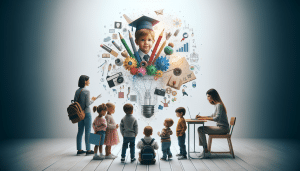You Can Unlock New Paths With Bilingual Education
Oliver Cooper September 13, 2025
Explore how bilingual education opens new opportunities, supports childhood development, and enhances cultural understanding in education and society. Learn about cognitive benefits, common challenges, and practical steps for families interested in dual-language programs.
Bilingual Education Fundamentals Everyone Should Know
Bilingual education is an approach where students learn core academic content through two languages. This model is growing in popularity as communities become increasingly diverse and global mobility rises. Many families see it as a way to give children skills for a connected world. Whether in Spanish and English, French and Mandarin, or other language pairs, students face day-to-day immersion in both languages, which builds strong communication foundations. Programs differ, but most offer consistent instruction in each language, helping children develop literacy and confidence simultaneously. The presence of bilingual programs in public schools is a clear reflection of education adapting to changing societal demands.
The structure of bilingual education does not just support language learning. It also promotes academic achievement across subjects like math, science, and social studies in both languages. Research suggests that children who receive education in two languages often outperform peers in traditional single-language settings, especially in reading and problem-solving. Schools offering these programs typically recruit highly qualified teachers fluent in both languages, ensuring students receive accurate, culturally relevant instruction. As a result, students gain a broader view of the world, appreciating multiple perspectives from an early age. Instructional approaches may vary, but the core objective remains the same: nurturing bilingual and biliterate individuals ready for modern careers (https://www.edutopia.org/article/two-way-bilingual-program-benefits).
The evolution of bilingual education in society has not been without debate. Critics sometimes worry about children becoming confused or lagging behind in academic performance. However, multiple studies have addressed these concerns, showing that, after an initial adjustment, students often excel in school and develop advanced cognitive flexibility. In addition, many communities now view dual-language programs as an asset, supporting diversity, fostering social cohesion, and reflecting global realities. Ultimately, bilingual education is more than learning another language — it’s a comprehensive strategy to build resilient, adaptable citizens who can thrive in a multicultural society.
Cognitive Advantages of Bilingual Learning Environments
Bilingual education offers robust cognitive benefits for learners of all ages. Observations from leading educational researchers highlight the ability of bilingual students to multitask efficiently, switch between assignments with ease, and demonstrate sharper problem-solving skills compared to their monolingual peers. This adaptability is due in part to the regular practice of moving between linguistic systems, which strengthens the brain’s executive function. Children engaged in dual-language instruction consistently rank higher in memory, attention control, and analytical thinking. These skills are invaluable, setting students up for success well beyond the classroom (https://www.ncbi.nlm.nih.gov/pmc/articles/PMC3583091/).
Recent studies in neuroscience back up these findings. Bilingual individuals use both sides of the brain more actively during language tasks, Iearning to focus and block distractions as they translate and interpret. Over time, the mental workout from bilingualism may help delay cognitive aging and even lower the risk of neurodegenerative diseases. School programs that reinforce language proficiency in both native and non-native tongues give children opportunities to stretch their mental limits in new ways. The impact is clear: instructional environments that promote two languages are nurturing comprehensive cognitive growth.
Cognitive flexibility gained through bilingual instruction is not limited to young learners. Adults who engage in ongoing bilingual education—such as through continuing ed or volunteer programs—also report increased creativity and better adaptability at work. Companies increasingly value employees who can think on their feet and bridge cultural divides. This ripple effect means bilingual education is not only helping individual students; it is also supporting innovation and collaboration in society at large.
Cultural Competence and Social Benefits in Bilingual Programs
A standout feature of bilingual education is the promotion of cultural competence and cross-cultural understanding. Students remain connected to their heritage language while gaining new insights into other cultures, which helps foster empathy and a global mindset. Schools often celebrate diverse traditions, holidays, and histories, exposing students to multiple worldviews from an early age. This inclusive climate reduces prejudice and supports positive relationships among classmates of different backgrounds.
Participating in bilingual programs can also lead to improved self-esteem among students. By validating students’ native languages, schools send a powerful message about the value of identity and diversity. Many bilingual education initiatives create close-knit communities, encouraging families to engage with schools and share their own experiences. This strengthens support networks around learners, making the transition to school feel less daunting and more welcoming, especially for newcomers or children from immigrant families (https://www.colorincolorado.org/article/why-promote-bilingualism).
Through bilingual education, society benefits from the cultivation of individuals who act as bridges between cultures. These students often serve as informal translators within their communities and develop leadership skills in multicultural settings. As they grow older, they become advocates for inclusion and are likely to participate in projects that promote mutual understanding. Bilingual education, therefore, is more than a classroom strategy — it’s a foundation for building equitable, connected communities.
Common Challenges in Dual-Language Instruction
Despite its many advantages, bilingual education faces significant implementation challenges. Many schools report shortages of certified bilingual teachers, and existing staff often shoulder heavy workloads covering both content and language instruction. Building a balanced curriculum, where each language gets adequate time and attention, requires ongoing coordination and resources. Schools must invest in appropriate materials and regular professional development to ensure high instructional quality in both languages.
Parental support is another crucial factor. Some families worry that their children will struggle academically or lose proficiency in the community language. Open communication and information sessions can help address these concerns, pointing to long-term research showing strong academic outcomes. Additionally, finding textbooks, library materials, or digital resources in both languages is not always easy—particularly for less common language pairs. This makes cross-institutional cooperation and resource sharing essential (https://www.ericdigests.org/2001-4/dual.html).
Measuring bilingual students’ progress presents further challenges. Standardized tests are usually in one language, failing to reflect a student’s achievements across all areas. Schools and districts are experimenting with new evaluation tools and portfolio assessments that show true bilingual proficiency. Progress continues as educators, researchers, and policymakers refine methods for assessing, supporting, and advocating for the growth of dual-language programs.
How Bilingual Education Supports Future Career Success
The link between language proficiency and career opportunities is well documented across global job markets. Bilingual or multilingual candidates are sought after by employers who value adaptability, cultural understanding, and expanded communication channels. In fields such as business, healthcare, and public policy, the ability to work in two languages can set applicants apart in competitive hiring situations. Career-readiness is being redefined as educators prepare students to thrive in diverse and interconnected work environments.
Professional organizations and universities have introduced credentialing systems to recognize bilingual ability. Beyond traditional diplomas, students can earn seals of biliteracy, attesting to their command of two or more languages. This opens unexpected doors—internships abroad, translation roles, and global leadership tracks become potential pathways. These expanding options highlight the long-term benefits of participating in bilingual education from an early stage (https://www.sealofbiliteracy.org/).
Investing in bilingual education is, therefore, a strategic choice for individuals and societies alike. Not only does it prepare students for future careers, but it also positions entire communities to engage meaningfully in an ever-more globalized world. By making dual-language programs accessible now, we support equity, economic mobility, and lifelong learning for generations to come.
Practical Steps for Families Considering Bilingual Programs
Many parents wonder how to support their children in a bilingual setting. The first step is to explore what options are available near their homes—public, charter, or private schools may have differing program models. Attending informational sessions or talking with current families can offer real-world insights. It’s important to ask about qualifications of the teaching staff, instructional hours in each language, and school culture.
Home support is equally vital. Encouraging reading, conversation, and play in both languages helps anchor what students learn at school. Parents don’t need to be fluent — simply being interested and engaged is enough. Leveraging libraries, podcasts, and online resources can keep language learning fun and practical outside classroom walls. Some districts even organize parent education sessions to bridge language barriers and build community support (https://www.readingrockets.org/article/supporting-ELLs-home-and-instruction).
Children naturally pick up language at different rates; patience and positive reinforcement are key. Bilingual education is a long-term journey, not a race, and every learner’s path will look different. Families are encouraged to celebrate progress, connect with school staff, and participate in community events that broaden their understanding of language and culture. These small actions make a significant difference in student attitudes and language retention—a strong partnership between families and schools amplifies the impact of dual-language programs and benefits the whole society.
References
1. Edutopia. Two-Way Bilingual Programs Benefit All: A Closer Look. Retrieved from https://www.edutopia.org/article/two-way-bilingual-program-benefits
2. Bialystok, E., Craik, F. I. M., & Luk, G. (2012). Bilingualism: Consequences for Mind and Brain. Trends in Cognitive Sciences, 16(4), 240–250. Retrieved from https://www.ncbi.nlm.nih.gov/pmc/articles/PMC3583091/
3. Colorín Colorado. Why Promote Bilingualism in Schools? Retrieved from https://www.colorincolorado.org/article/why-promote-bilingualism
4. ERIC Digests. Dual Language Programs: Current State of the Art. Retrieved from https://www.ericdigests.org/2001-4/dual.html
5. The Seal of Biliteracy. The Seal of Biliteracy: Recognizing Student Achievement. Retrieved from https://www.sealofbiliteracy.org/
6. Reading Rockets. Supporting ELLs at Home and in Instruction. Retrieved from https://www.readingrockets.org/article/supporting-ELLs-home-and-instruction







